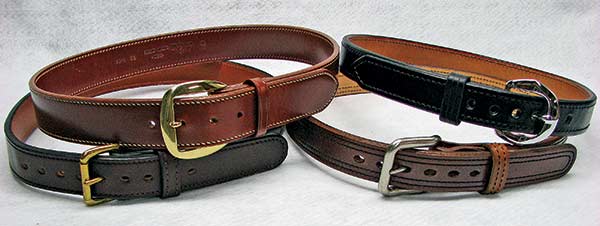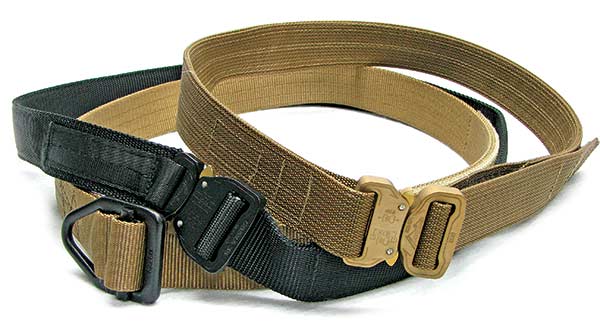Sizing Up A Quality Gun Belt

These belts from four vendors demonstrate the variety available in
high-quality leather for informal wear. Clockwise from 7:00: Daltech’s
super-stiff dual layer 0.30"-thick bull hide, Galco’s single layer 0.25"-
thick Sport, Zlogonje’s dual-layer 0.30"-thick model and Armour
Belt’s dual-layer 0.32"-thick model.
A proper gun belt is purpose-built for the task. It’s not a generic belt bought at Wal-Mart. It will support the weight of your holstered handgun, extra mag, light, phone, chemical spray and other gear without shifting, sagging or letting your gun flop. Excellent gun belts are available in leather, webbing and other synthetic materials. Belts constructed from each material can be arbitrarily flexible or stiff, which is largely a matter of personal preference and the gear you carry.
An outside the waistband holster (OWB) requires “more belt” than an IWB, since with it your pants do part of the job of supporting and concealing the gun. Belts usually come in 1.25″, 1.5″ and 1.75″ widths. A wider belt will carry the gun more securely, but may not be comfortable or fit your dress style. Don’t forget to match the width of the belt exactly to the width of your holster slots or loops, or your holster will be constantly changing angles.
Much is made on the ignorant, er … Internet forums of belt stiffness. Stiff is good, but can be overdone for your particular application, and too much can be uncomfortable. It’s a matter of finding the Goldilocks “just right” solution for you, your gun and holster.

Here’s three excellent “web” representatives (from bottom): Galco’s dual-layer,
Blade-Tech’s reinforced dual-layer Talon Tactical’s dual-layer model. Each uses
a different blend of materials to achieve a specific level of rotational and
longitudinal rigidity. Note the Talon belt has the Velcro length-adjustment
on the male end of the buckle, while the Blade-Tech has the adjustment on the female end.
Leather belts are traditional, organic and have been used for generations to hold up heavy sidearms. They can be single-layer, double-layer or double-layer with reinforcing material. You won’t really know what’s right for you until you try two, see the difference and then interpolate to the right mix of characteristics for you.
Web(ing) belts likewise come in a wide variety of materials, thicknesses and layers (also sometimes with reinforcing material). “Scuba” webbing generally denotes a stiff web material, but stiffness can be accomplished in other ways. Web belts come with various types of buckles, and one advantage of them is they are usually infinitely adjustable. Many buckles are advertised as super-strong, which is cool but not really necessary to hold your gun reliably in position. Web belts are intrinsically more casual than leather belts, and you’ll have to try at least two to get an idea of how much you like or dislike what’s different.
Like finding the perfect holster, finding just the right belt is a process, but a worthwhile one. We’ve assembled some ideas here so take what works and put it to use.






